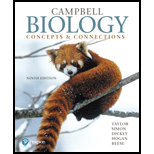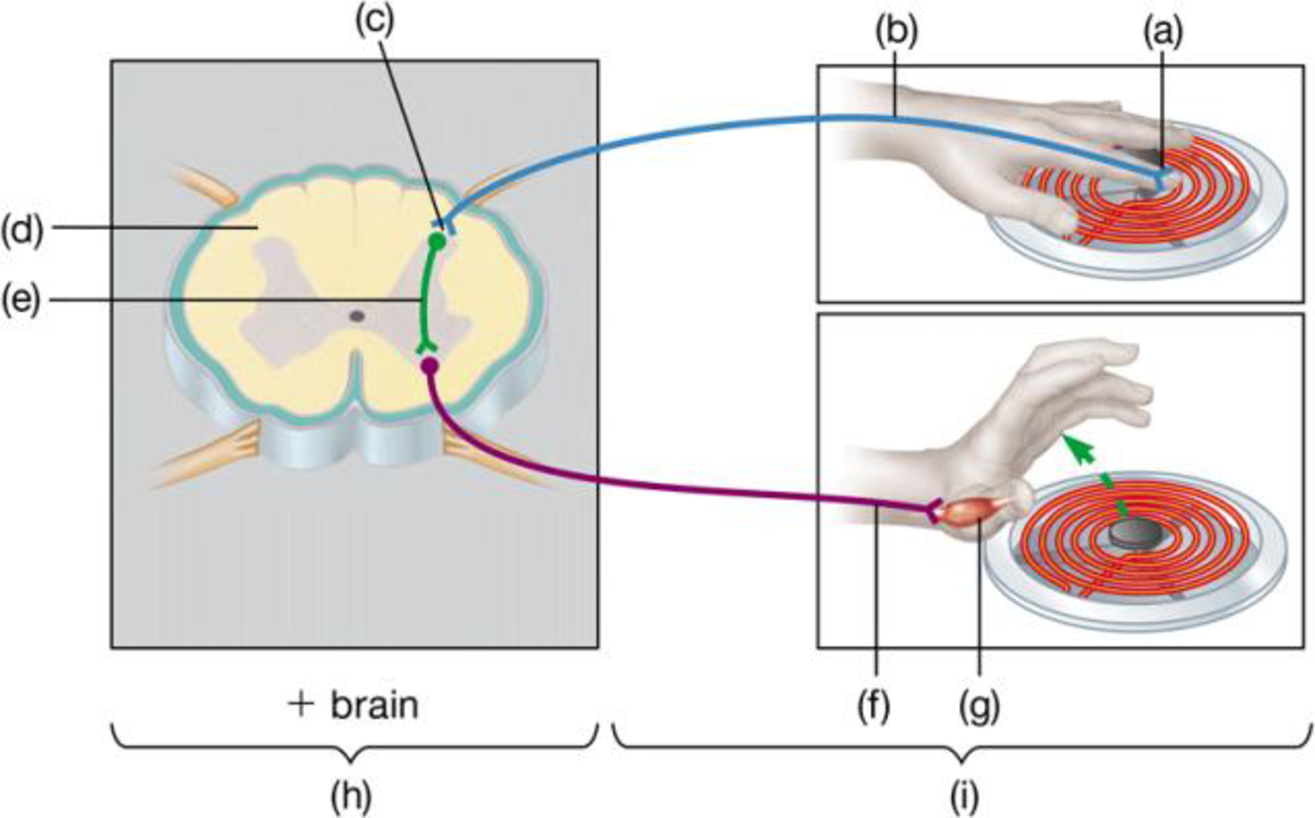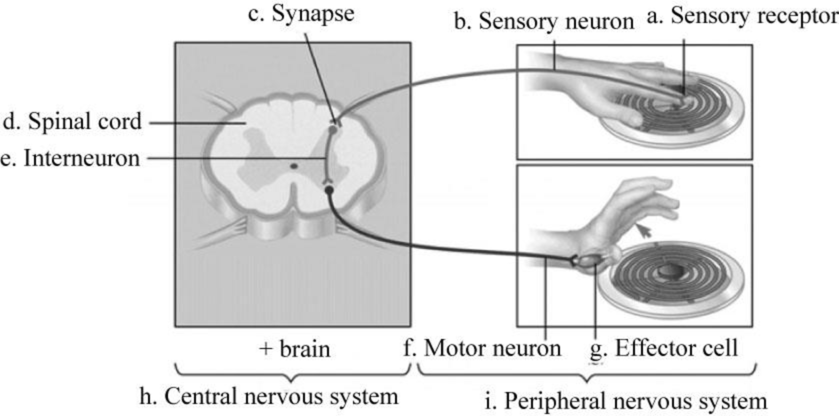
Test your understanding of the nervous system by matching the following labels with their corresponding letters: CNS, effector cells, interneuron, motor neuron, PNS, sensory neuron, sensory receptor, spinal cord, synapse.

To label: The system involved in reflex action and also to list the points that take part in conduction of nerve signals during the process.
Concept introduction: A collection of nerves, the brain, and the spinal cord that together help in regulation of signals from one part of the body to another is called the nervous system. The primary unit of the nervous system is a specialized cell that is termed as a neuron.
Answer to Problem 1CC
Pictorial representation: Fig.1 shows the systems involved in transmission of signal and response generated by the brain.

Fig.1: System involved in nerve conduction
Explanation of Solution
(a)
Correct answer: Sensory receptor.
Sensory receptors are present on dendrites to neurons that are specialized in receiving signals from the environment. The receptor that receives a signal from the external environment is termed as external sensory receptor, whereas the receptor that receives a stimulus from the internal environment is termed as an internal sensory receptor. Hence, the correct answer is a sensory receptor.
(b)
Correct answer: Sensory neuron.
Sensory neurons are the neurons that specialize in transferring the stimulus from the sensory receptor to the brain or spinal cord. The movement of stimulus through the sensory neurons is termed as sensory induction. Hence, the correct answer is a sensory neuron.
(c)
Correct answer: Synapse.
Synapse is the site where the signal passes to the next neuron or to the effector cell with the help of an electrical or a chemical signal (neurotransmitter). Hence, the correct answer is synapse.
(d)
Correct answer: Spinal cord.
The spinal cord is a part of the central nervous system. Transmission of a nerve signal from the sensory neuron to the brain for further processing is done with the help of the spinal cord and the neurons that are present in it. Hence, the correct answer is spinal cord.
(e)
Correct answer: Interneuron
Interneuron is a part of the central nervous system that helps in conveying the signals between sensory neuron and motor neuron. Interneuron is found in the spinal cord. Hence, the correct answer is an interneuron.
(f)
Correct answer: Motor neuron.
Motor neuron conducts the movement of signals from the brain and spinal cord to the cell where the response is needed. Cell body of a motor neuron is located in the spinal cord and the axon part of the cell is located toward muscle or gland where action is needed. Hence, the correct answer is a motor neuron.
(g)
Correct answer: Effector cell.
Effector cell is present in the glands and muscles. It receives the signal from the motor neuron and generates a physiological response in the body part. Hence, the correct answer is an effector cell.
(h)
Correct answer: Central nervous system.
The central nervous system (CNS) is responsible for actions that the body takes in response to an external stimulus. It receives the signal from the receptors, processes the reflex by the CNS, and transmits a signal to the effector cell. The central nervous system consists of two main parts: the spinal cord and the brain. Hence, the correct answer is the central nervous system.
(i)
Correct answer: Peripheral nervous system.
The peripheral nervous system consists of nerves and their neurons. It includes receptor cell, sensory neuron, interneuron, motor neuron, and effector cell. PNS connects the body to CNS. Hence, the correct answer is the peripheral nervous system.
Want to see more full solutions like this?
Chapter 28 Solutions
Campbell Biology: Concepts & Connections (9th Edition)
- Determine how much ATP would a cell produce when using fermentation of a 50 mM glucose solution?arrow_forwardDetermine how much ATP would a cell produce when using aerobic respiration of a 7 mM glucose solution?arrow_forwardDetermine how much ATP would a cell produce when using aerobic respiration to degrade one small protein molecule into 12 molecules of malic acid, how many ATP would that cell make? Malic acid is an intermediate in the Krebs cycle. Assume there is no other carbon source and no acetyl-CoA.arrow_forward
- Identify each of the major endocrine glandsarrow_forwardCome up with a few questions and answers for umbrella species, keystone species, redunant species, and aquatic keystone speciesarrow_forward19. On the diagram below a. Label the three pictures as: DNA; polypeptide; or RNA. b. Label the arrows as: translation or transcription/RNA processing. c. Add the following details to the diagram. Promoter region TATA box Transcription start site Transcription terminator Intron (A,B,C,D) Exons (1,2,3,4,5) Splice sites 5' cap 5' UTR (untranslated region) 3' poly A tail 3' UTR (untranslated region) Translational start (AUG) Translational stop (UGA, UAG, or UAA) N and C ends of polypeptide 0000arrow_forward
- Match the letter labels in the figure below to the terms. Some letter labels are not used. MNNNNNNIN M C B A M D F E H K G 8arrow_forwardThe diagram below illustrates a quorum sensing pathway from Staphylococcus aureus. Please answer the following questions. 1. Autoinduction is part of the quorum sensing system. Which promoter (P2 or P3) is critical for autoinduction? 2)This staphylococcus aureus grows on human wounds, causing severe infections. You would like to start a clinical trial to treat these wound infections. Please describe: a) What molecule do you recommend for the trial. Why? b) Your trial requires that Staphylococcus aureus be isolated from the wound and submitted to genome sequencing before admittance. Why? What are you testing for? 3) If a mutation arises where the Promoter P3 is constitutively active, how would that influence sensitivity to AIP? Please explain your rationale. 4) This pathway is sensitive to bacterial cell density. Describe two separate mutation that would render the pathway active independent of cell density. Briefly explain your rationale. Mutation 1 Mutation 2arrow_forwardThere is currently a H5N1 cattle outbreak in North America. According to the CDC on Feb 26*: "A multistate outbreak of HPAI A(H5N1) bird flu in dairy cows was first reported on March 25, 2024. This is the first time that these bird flu viruses had been found in cows. In the United States, since 2022, USDA has reported HPAI A(H5N1) virus detections in more than 200 mammals." List and describe two mechanisms that could lead to this H5N1 influenza strain evolving to spread in human: Mechanisms 1: Mechanisms 2: For the mutations to results in a human epidered they would need to change how the virus interacts with the human host. In the case of mutations that may promote an epidemic, provide an example for: a protein that might incur a mutation: how the mutation would change interactions with cells in the respiratory tract (name the receptor on human cells) List two phenotypic consequence from this mutation that would increase human riskarrow_forward
- You have a bacterial strain with the CMU operon: a) As shown in the image below, the cmu operon encodes a peptide (Pep1), as well as a kinase and regulator corresponding to a two-component system. The cmu operon is activated when Pep 1 is added to the growth media. Pep1 is a peptide that when added extracellularly leads to activation of the Cmu operon. Pep1 cmu-kinase cmu-regulator You also have these genetic components in other strains: b) An alternative sigma factor, with a promoter activated by the cmu-regulator, that control a series of multiple operons that together encode a transformasome (cellular machinery for transformation). c) the gene cl (a repressor). d) the promoter X, which includes a cl binding site (and in the absence of cl is active). e) the gene gp (encoding a green fluorescence protein). Using the cmu operon as a starting point, and assuming you can perform cloning to rearrange any of these genomic features, how would you use one or more of these to modify the…arrow_forwardYou have identified a new species of a Gram-positive bacteria. You would like to screen their genome for all proteins that are covalently linked to the cell wall. You have annotated the genome, so that you identified all the promoters, operons, and genes sequences within the operons. Using these features, what would you screen for to identify a set of candidates for proteins covalently linked to the bacterial cell wall.arrow_forwardBelow is a diagram from a genomic locus of a bacterial genome. Each arrow represents a coding region, and the arrowheads indicate its orientation in the genome. The numbers are randomly assigned. Draw the following features on the diagram, and explain your rationale for each feature: 10 12 合會會會會長 6 a) Expected transcriptions, based on known properties of bacterial genes and operons. How many proteins are encoded in each of the transcripts? b) Location of promoters (include rationale) c) Location of transcriptional terminators (include rationale) d) Locations of Shine-Dalgarno sequences (include rationale)arrow_forward
 Human Physiology: From Cells to Systems (MindTap ...BiologyISBN:9781285866932Author:Lauralee SherwoodPublisher:Cengage Learning
Human Physiology: From Cells to Systems (MindTap ...BiologyISBN:9781285866932Author:Lauralee SherwoodPublisher:Cengage Learning Anatomy & PhysiologyBiologyISBN:9781938168130Author:Kelly A. Young, James A. Wise, Peter DeSaix, Dean H. Kruse, Brandon Poe, Eddie Johnson, Jody E. Johnson, Oksana Korol, J. Gordon Betts, Mark WomblePublisher:OpenStax College
Anatomy & PhysiologyBiologyISBN:9781938168130Author:Kelly A. Young, James A. Wise, Peter DeSaix, Dean H. Kruse, Brandon Poe, Eddie Johnson, Jody E. Johnson, Oksana Korol, J. Gordon Betts, Mark WomblePublisher:OpenStax College Human Biology (MindTap Course List)BiologyISBN:9781305112100Author:Cecie Starr, Beverly McMillanPublisher:Cengage Learning
Human Biology (MindTap Course List)BiologyISBN:9781305112100Author:Cecie Starr, Beverly McMillanPublisher:Cengage Learning Biology: The Dynamic Science (MindTap Course List)BiologyISBN:9781305389892Author:Peter J. Russell, Paul E. Hertz, Beverly McMillanPublisher:Cengage Learning
Biology: The Dynamic Science (MindTap Course List)BiologyISBN:9781305389892Author:Peter J. Russell, Paul E. Hertz, Beverly McMillanPublisher:Cengage Learning





